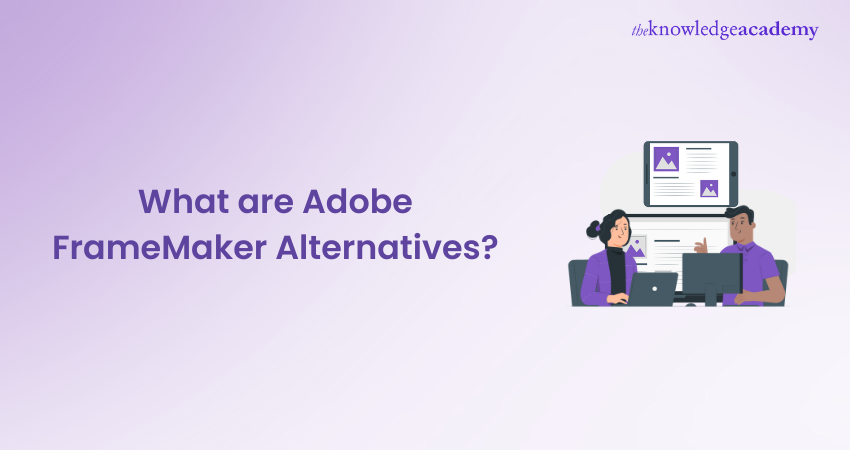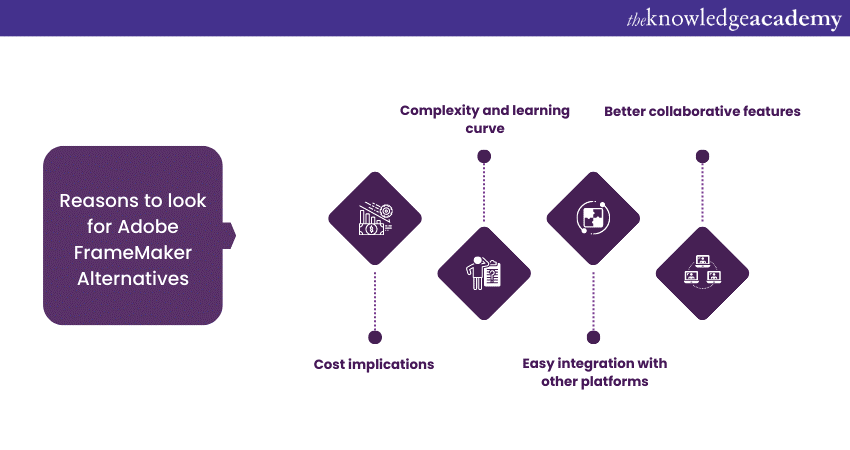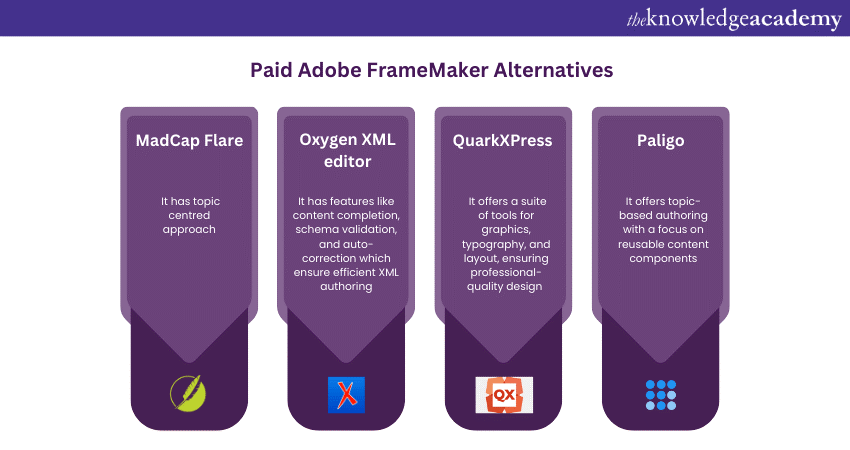We may not have the course you’re looking for. If you enquire or give us a call on 01344203999 and speak to our training experts, we may still be able to help with your training requirements.
Training Outcomes Within Your Budget!
We ensure quality, budget-alignment, and timely delivery by our expert instructors.

Adobe FrameMaker has long been the go-to software for professionals dealing with complex documents and technical publications. However, its learning curve and pricing structure may not suit everyone. As a result, a range of Adobe FrameMaker Alternatives has emerged, offering similar functionalities at varying price points and usability levels. The alternatives of Adobe FrameMaker provide options for XML editing, single-sourcing, and content management, making it easier to manage extensive documentation projects.
According to 6sense, Adobe FrameMaker has a market share of 4.95%. The other alternatives to Adobe FrameMaker give quite good competition and are worthy to use. Read this blog to learn what Adobe FrameMaker Alternatives are and why looking for an alternative is necessary. In this blog, we have also discussed paid and free alternatives to Adobe FrameMaker.
Table of Contents
1) What is Adobe FrameMaker?
2) Why look for Adobe FrameMaker Alternatives?
3) Paid Adobe FrameMaker Alternatives
4) Adobe FrameMaker Free Alternative
5) Conclusion
What is Adobe FrameMaker?
So, what is Adobe FrameMaker? It is a comprehensive document processing application specifically tailored for creating and editing large, structured documents. Launched by Adobe Systems, this software has become the preferred choice for technical writers, industries, and authors with extensive documentation.
FrameMaker's unique advantage lies in its ability to manage vast volumes of data, from manuals to detailed reports, in a consistent format. Its structured authoring environment also ensures that content follows a logical hierarchy, making information easily accessible to readers.
Why look for Adobe FrameMaker Alternatives?
Even though Adobe FrameMaker is the go-to option for creating technical and digital documents, there are some of its alternatives that are worthy of your attention. The following are some of the points We have discussed some points which will help you to figure out why you need to look for some other alternatives as well:

Cost implications
A primary concern for many, especially individuals, startups, and small enterprises, is the cost associated with premium tools like Adobe FrameMaker. Investing in such a solution might be justifiable for a large corporation that regularly churns out volumes of technical documents. However, the investment might be hard to justify for smaller projects or organisations with limited financial resources. Consequently, these users often look for more cost-effective or even free alternatives that balance functionality and affordability.
Complexity and learning curve
There's no denying that Adobe FrameMaker is a powerhouse regarding features. But with great power comes a certain level of complexity. If you are among one of these new users or are transitioning from simpler platforms, you might find FrameMaker's environment overwhelming. The steep learning curve can deter potential users who require a quicker adoption pace, pushing them towards more user-friendly alternatives.
Integration with other platforms
Integration capability is crucial if you make digital content or technical documents. Some teams often use various tools in tandem – for collaboration, content management, version control, and more. If a tool like Adobe FrameMaker doesn't seamlessly integrate with other platforms a team uses, it might result in inefficient workflows or data silos. Some users seek alternatives that offer better integration capabilities, ensuring smooth data flow and collaboration across platforms.
Scalability concerns
While Adobe FrameMaker is equipped to handle large volumes of content, you may sometimes have scalability concerns. You will find these issues difficult if you are working on rapidly expanding projects or dealing with vast databases. In such situations, you might seek alternatives that assure consistent performance, irrespective of the scale of documentation.
Collaborative features
Modern work culture heavily emphasises collaboration. Real-time editing, commenting, and reviewing have become standard expectations for many software platforms. If Adobe FrameMaker lacks these collaborative features or its collaborative tools aren't as intuitive as those in other platforms, you can explore alternative solutions that better cater to collaborative needs.
Experience top-notch Adobe Training that fuels your creativity! Start learning today and watch your projects come to life.
Adapting to modern trends
The world of digital publishing and content creation is always evolving. Trends like interactive documentation, embedded multimedia, and responsive design for multiple devices are becoming increasingly popular. If you feel that FrameMaker is not adapting swiftly to these modern requirements or if other tools offer more innovative features, you can look for these alternative solutions.
Customisation and flexibility
While Adobe FrameMaker offers many features, some of you may feel restricted in terms of customisation. The ability to make a platform unique to specific needs, workflows, or branding can be crucial for certain teams or projects. You can look for more flexibility in customisation options. These options may give you the solutions that will allow you to mould the software environment according to their preferences.
Software stability and updates
Like any software, Adobe FrameMaker isn't immune to bugs or stability issues. While Adobe frequently addresses these concerns with updates, there might be periods when you can encounter consistent problems. Frequent crashes, unexpected behaviour, or slow performance can be detrimental to productivity. If you feel that alternative solutions offer better stability or more frequent feature updates, you can start looking for these alternatives.
Platform dependency
Adobe FrameMaker is not universally compatible with all operating systems. It can be a limiting factor for teams or individuals like you, if you are using non-supported systems. If you find yourselves constrained by such platform dependencies, you can look for more versatile alternatives that offer broader compatibility.
Community and support
A strong user community and robust support system can significantly enhance a software's appeal. Users like you often turn to community forums, tutorials, and support channels for troubleshooting, tips, or best practices. If you feel that other platforms offer better community support or more responsive customer service, you can gravitate towards those platforms.
Master the art of technical documentation with our Adobe FrameMaker Training.
Paid Adobe FrameMaker Alternatives
There are several paid tools that have emerged as viable alternatives to FrameMaker. Let's dive deeper into some of these paid alternatives to see what they offer.

a) MadCap Flare
MadCap Flare is often the first name that comes to mind when discussing FrameMaker alternatives. It's a modern solution designed specifically for creating technical documentation, help systems, and online content. Here are some of its key features:
a) Topic-based authoring: Like FrameMaker, Flare is based on a topic-centred approach. This allows writers to create modular and reusable content.
b) Single source publishing: Produce content for multiple channels and formats from a single source, saving time and ensuring consistency.
c) Integrated content management: Flare integrates with MadCap Central, a cloud-based content management solution tailored for technical documentation.
d) Responsive design: Easily create content that adapts to various screen sizes and devices without requiring separate versions.
b) Oxygen XML editor
Oxygen XML editor is a tool geared more towards users comfortable with XML-based authoring. It offers a large range of tools for editing, transforming, and publishing XML documents. Here are its key features:
a) XML authoring: Features like content completion, schema validation, and auto-correction ensure efficient XML authoring.
b) Transformation and conversion: Convert XML files to other formats like PDF, HTML, and EPUB with ease.
c) Extensibility: Users can extend the tool's functionality using plugins or scripts, ensuring adaptability to specific workflows.
d) Collaboration: Features like change tracking, comments, and merging facilitate collaborative XML authoring.
c) QuarkXPress
QuarkXPress, predominantly known for desktop publishing, also provides capabilities for creating long-form documents. It's a popular choice for professionals in design and layout roles. The key features are:
a) Intuitive design tools: QuarkXPress offers a suite of tools for graphics, typography, and layout, ensuring professional-quality design.
b) Digital publishing: Create interactive digital publications, including eBooks, flipbooks, and mobile app content.
c) Flex layouts: Design web pages without needing to code, ensuring responsive design across devices.
d) Integration with other tools: Seamlessly import content from software like Photoshop or Illustrator.
d) Paligo
Paligo is a cloud-based documentation platform that emphasises collaboration, scalability, and the modern user experience. These are its key features:
a) Structured authoring: Paligo offers topic-based authoring with a focus on reusable content components.
b) Collaborative environment: As a cloud-based solution, Paligo excels in collaborative features, allowing teams to work together in real-time.
c) Localisation: Built-in translation tools facilitate the creation of content in multiple languages.
d) Integrations: Paligo integrates with popular platforms like Zendesk, Salesforce, and GitHub.
e) Help+Manual
Help+Manual is an authoring tool that is designed for creating software user manuals, help systems, and online documentation. The key features are:
a) Visual editor: A WYSIWYG editor ensures what you see is what you get, simplifying content creation.
b) Templates and skins: Pre-made templates make it easy to start a project, while customisation options allow for unique designs.
c) Team authoring: Teams can work together on projects, with tools for version control and collaboration.
d) Publishing options: Create content for various outputs, including HTML, PDF, ePUB, and more.
f) RoboHelp
Adobe's own RoboHelp, ironically, is sometimes seen as an alternative to FrameMaker, especially when the focus is on creating help systems, e-learning content, and knowledge bases. The key features are:
a) User-friendly interface: RoboHelp’s modern UI is intuitive, making content creation and management straightforward.
b) Dynamic content filters: Allow readers to filter content based on their preferences or needs, enhancing user experience.
c) HTML5 layouts: Out-of-the-box responsive designs ensure content is accessible across devices.
d) Real-time collaboration: Collaborative features ensure teams can work together efficiently.
g) PTC Arbortext
PTC Arbortext is a comprehensive solution that caters to the end-to-end process of content development and publication. It's particularly favoured in industries that require intricate, enterprise-scale documentation, such as aerospace or automotive sectors. The key features are as follows:
a) Advanced authoring: Provides a robust environment for creating structured content with XML-based authoring.
b) Dynamic publishing: Content can be published across multiple channels with the flexibility of dynamic content assembly.
c) Integrated graphics: In-built tools for creating and managing technical illustrations.
d) Content management: Comes with its Content Management System (CMS) tailored for documentation, ensuring content is versioned, reused, and managed efficiently.
h) CorelDRAW Technical Suite
While CorelDRAW is primarily known as a graphic design software, its Technical Suite is tailored for technical publications, illustrations, and documentation. These key features are as follows:
a) Technical illustration: Precision tools for creating detailed technical illustrations and diagrams.
b) Multi-format publishing: Allows publication in a variety of formats, ensuring content is accessible both in print and online.
c) 3D CAD repurposing: Easily repurpose 3D CAD models into your technical documents.
d) Advanced standards compliance: Supports standards such as S1000D, ensuring content is industry compliant.
Adobe FrameMaker Free Alternative
Now you have a list of paid Adobe FrameMaker Alternatives. Here, we are going to show you some free tools that you can use instead of using the FrameMaker:
a) Scribus
Scribus is an open-source desktop publishing software that is widely recognised for its robust set of features suitable for layout, typesetting, and preparing files. These features can be used to produce some professional-quality image-setting equipment. The key features of Scribus are:
a) Professional page layout: Offers tools similar to leading commercial applications for layout design.
b) PDF creation: Supports the creation of interactive PDFs, including forms.
c) Colour management: Provides a reliable colour management system, ensuring consistency across devices.
Extensibility: Being open source there's potential for customisation and extension with scripts.
b) DocBook
DocBook is more of a specification than a software. It's an XML or SGML markup language for technical documentation. Thus, it makes a structured alternative for those comfortable with direct code authoring. Some of the key features are:
a) Versatile output: With the right processing tools, DocBook can be converted to various output formats like HTML, PDF, EPUB, and more.
b) Highly structured: Being XML-based, it follows a strict structure, ensuring consistency in documentation.
c) Customisable styles: While it might require some XML knowledge, users can customise the look and feel of their content.
d) Widespread support: Many tools, both free and paid, support DocBook as a format, adding to its versatility.
c) LaTex
LaTex is a high-quality typesetting system that's particularly popular in academia, especially among STEM fields for its proficiency with formulae and structured documents. Some these key features are:
a) Advanced typesetting: Ideal for documents that require complex structures or mathematical formulas.
b) Extensive package system: Thousands of add-on packages are available, providing extended functionalities.
c) Platform independent: Works across Windows, macOS, and Linux.
d) Diverse output formats: Can produce output in various formats including PDF, HTML, and more.
d) Apache OpenOffice Writer
Apache OpenOffice Writer is a word processor and a component of the Apache OpenOffice software suite. While it’s akin to Microsoft Word, its capabilities extend to more advanced document design and layout. These are the following key features:
a) Familiar UI: Those acquainted with other word processors will find its interface intuitive.
b) Styles and formatting: Allows for complex document structures using styles.
c) Integrated graphics tools: Comes with drawing tools for basic graphic design.
d) Export to PDF: Directly export documents to PDF without needing additional software.
e) LyX
LyX combines the power and flexibility of TeX/LaTeX with the ease of a graphical interface. It's a document processor bridges the gap between classical word processing and a full-fledged typesetting system. The key features are as follows:
a) Visual interface: Unlike traditional LaTex editors, LyX offers a more visually intuitive interface. This simplifies the document creation process.
b) Mathematical formula editor: Has a powerful math editor, making it suitable for academic and scientific documents.
c) Structured document creation: Supports the creation of structured documents with tables, references, and more.
d) Multi-platform: Available for Windows, macOS, and Linux
f) Jutoh
While Jutoh has a paid version, its free version is still powerful enough for basic eBook creation, making it a potential alternative for those focused on digital publishing. These key features are:
a) E-book creation: With this you can efficiently create eBooks in popular formats like EPUB and MOBI.
b) Style management: Apply consistent styles across the document.
c) Cover design: Basic tools for designing eBook covers.
d) Metadata editor: Edit or add metadata to your eBooks for better discoverability.
g) Zim
Zim is a lightweight, wiki-style notebook application that's suitable for maintaining a collection of pages, each containing links to other pages, simple formatting, and images. The key features of Zim are:
a) Wiki-style editing: Easy to create and manage interconnected pages.
b) Plugin system: Extend the software's functionality using a variety of plugins.
c) Graphical attachments: Insert images, diagrams, and other graphical elements.
d) Export options: While its primary format is a wiki, Zim can export to HTML, LaTeX, and more.
h) LibreOffice Writer
LibreOffice Writer is a part of the LibreOffice suite, a powerful open-source office suite that serves as a free alternative to Microsoft Office. While it is primarily known as a word processor, its features extend beyond basic document creation and can be suitable for more advanced documentation and publishing needs. The key features are:
a) Advanced styles and formatting: Offers an array of tools for creating structured documents, including hierarchical styles, automatic table of contents, and more.
b) Master documents: Allows for the management of large documents by breaking them into smaller, more manageable files while still operating as a singular entity.
c) Export options: Beyond standard document formats, Writer can export directly to PDF and even offers limited capabilities for exporting to EPUB for eBooks.
d) Templates and extensions: The LibreOffice community has made available a multitude of templates and extensions, extending the software's capabilities further.
e) Drawing tools: Integrated tools for creating diagrams, flowcharts, and other illustrative content, enhancing the visual appeal of documents.
Conclusion
In the evolving landscape of technical documentation, numerous tools offer a range of functionalities. Whether you opt for FrameMaker or Adobe FrameMaker Alternatives, the key lies in choosing a tool that aligns with your project requirements. Choosing the right tool for your projects or tasks, helps you maintain improved product delivery.
Elevate your video editing skills with our Adobe Premiere Pro Courses.







 Top Rated Course
Top Rated Course




 If you wish to make any changes to your course, please
If you wish to make any changes to your course, please


